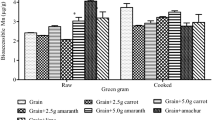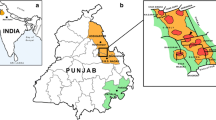Abstract
Selenium, an ultra trace element with several health beneficial attributes, should be mainly derived from dietary sources. Since food processing is likely to alter the bioavailability of micronutrients, the influence of such processing such as germination and fermentation on selenium content and bioaccessibility, information on which is lacking, was examined in this study. Bioaccessibility of selenium from four cereal-based composite meals was also studied. Chickpea, green gram and finger millet were employed to study the effect of germination, and for effect of fermentation, batters used in preparation dosa, idli and dhokla were used. Soaking the grains in water as a part of germination and fermentation brought about a decrease in selenium content, while its bioaccessibility was not affected. The information on the loss of selenium during soaking and heat processing of the germinated grains is novel. Fermentation resulted in a further decrease in selenium content, the percent decrease ranging from 26 to 47 in the batters. Similar decreases were seen in the bioaccessible selenium content as a result of soaking and fermentation. Cooking of the fermented batters, however, significantly enhanced the bioaccessibility of selenium from dosa and dhokla by 44 and 71 %, respectively. Selenium content of the four meals ranged from 150 to 228.8 ng/g. Bioaccessible selenium was highest in the finger millet-based meal (32.8 ng/g), followed by sorghum, wheat and rice-based meals. The present investigation thus provides vital and novel information on selenium content and bioaccessibility from foods subjected to processing as is commonly practiced in Indian households.
Similar content being viewed by others
References
Ahmad GN, Mubarak AE, EL- Beltagy AE (2008) Nutritional potential and functional properties of Tempe produced from mixture of different legumes. 1: chemical composition and nitrogenous constituent. Int J Food Sci Technol 43:1754–1758
Arthur JR, Beckett GJ (1994) Symposium: 2 newer aspects of micronutrient in at risk groups. New metabolic roles of selenium. Proc Nutr Soc 53:615–624
Bhavyashree SH, Jamuna P, Kalpana P, Srinivasan K (2009) Bioaccessibility of minerals from cereal-based composite meals and ready-to-eat foods. J Food Sci Technol 46(5):431–435
Christine H, Rosalind SG (2007) Symposium: food – based approaches to combating micronutrient deficiencies in children of developing countries. traditional food processing and preparation practices to enhance the bioavailability of micronutrients in plant based diets. J Nutr 137:1097–1100
Clark LC, Combs GF, Turnbull BW, Slate EH, Chalker DK, Chow J, Davis LS, Glover RA, Graham GF, Gross EG, Krongrad A, Lesher JL, Park K, Sanders BB, Smith CL, Taylor R (1996) Effects of selenium supplementation for cancer prevention in patients with carcinoma of the skin : a randomized controlled trial. JAMA 276:1957–1963
Frias J, Piotr G, Cristina MV, Radoslaw P, Enrique B, Begon J, Krzysztof G, Concepcion VV (2009) Influence of germination with different selenium solutions on nutritional value and cytotoxicity of lupin seeds. J Agric Food Chem 57:1319–1325
Frias J, Piotr G, Cristina MV, Elena P, Mariusz KP, Halina K, Ewa C, Krzysztof G, Concepcion VV (2010) Changes in nutritional value and cytotoxicity of garden cress germinated with different selenium solutions. J Agric Food Chem 58:2331–2336
Grant TD, Montes-Bayona M, LeDucb D, Fricke MW, Terry N, Caruso JA (2004) Identification and characterization of Se-methyl selenomethionine in Brassica juncea roots. J Chromatogr A 1026:159–166
Hemalatha S, Platel K, Srinivasan K (2007) Influence of germination and fermentation on bioaccessibility of zinc and iron from food grains. Eur J Clin Nutr 61:342–348
ICMR (2010) Nutrient requirements and recommended dietary allowances for Indians. Indian council of medical Research, New Delhi
Ip C (1998) Lessons from basic research in selenium and cancer prevention. J Nutr 128:1845–1854
Jood S, Khetarpaul N (2005) Improving nutritional quality of coarse cereals through probiotic fermentation. Processed Food Industry 9:7–25
Julien C, Veronique V, Anthony N, Bertrand C, Pierre B, Ryszard L, Jean-Max R (2001) Selenium from selenium rich spirulina is less bioavailable than selenium from sodium selenite and selenomethionine in selenium deficient rats. J Nutr 131:2343–2350
Kabata PA, Pendias H (2001) Trace elements in soils and plants, 3rd edn. CRC press, Boca Raton, FL
Kapolna E, Shah M, Joseph AC, Fodor P (2007) Selenium speciation studies in Se-enriched chives (allium schoenoprasum) by HPLC-ICP-MS. Food Chem 101:1398–1406
Luten J, Crews H, Flynn A, Dael PV, Kastenmayer P, Hurrell R, Deelstra H, Shen LH, Fairweather-Tait S, Hickson K (1996) Inter-laboratory trial on the determination of the in vitro iron dialyzability from foods. J Sci Food Agric 72:415–424
Marco R, Petru J, Carlo B (2014) Selenium biochemistry and its role for human health. Metallomics 6:25–54
Odumodu CU (2007) Optimum fermentation period for micronutrients content of cereal based complementary food. Pak J Nutr 6:518–523
Praveen KP, Hazeena BV, Kumaravel S (2012) Mineral nutrients of ‘pazhaya sadham’: a traditional fermented food of Tamil Nadu, India. Int J Nutr Metab 4:151–152
Pugalenthi M, Vadivel V (2005) Nutritional evaluation and the effect of processing methods on antinutritional factors of sword bean (canavalia gladiata (jacq.) DC). J Food Sci Technol 42:510–516
Rayman MP (2005) Selenium in cancer prevention. A review of the evidenced mechanism of action. Proc Nutr Soc 64:527–542
Slejkovec Z, Van Elteren JT, Woroniecka UD, Kroon KJ, Falnoga I, Byrne AR (2000) Preliminary study on the determination of selenium compounds in some selenium-accumulating mushrooms. Biol Trace Elem Res 75:139–155
Valdiglesias V, Pasaro E, Mendez J, Laffon B (2010) In vitro evaluation of selenium genotoxic, cytotoxic and protective effects: a review. Arch Toxicol 84:337–351
Younju C, Jiyung K, Haeng-Shin L, Cho-il K, In Kyeong H, Hye KP, Chang-Hwan O (2009) Selenium content in representative Korean foods. J Food Compost Anal 22:117–122
Acknowledgments
The first author acknowledges the Indian Council of Medical Research, New Delhi, India, for the award of fellowship. The authors gratefully acknowledge Dr.K.Srinivasan, Chief Scientist, Department of Biochemistry & Nutrition, CSIR-CFTRI, for his very useful and constructive suggestions throughout the study. This work was financially supported by the 12th Five-year plan project of the Institute, WELFO (BSC 0202).
Author information
Authors and Affiliations
Corresponding author
Rights and permissions
About this article
Cite this article
Khanam, A., Platel, K. Influence of domestic processing on the bioaccessibility of selenium from selected food grains and composite meals. J Food Sci Technol 53, 1634–1639 (2016). https://doi.org/10.1007/s13197-015-2075-x
Revised:
Accepted:
Published:
Issue Date:
DOI: https://doi.org/10.1007/s13197-015-2075-x




